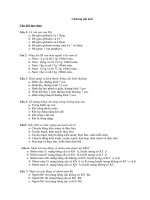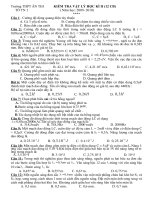tài liệu – page 2 – tâm lý học vb2k04
Bạn đang xem bản rút gọn của tài liệu. Xem và tải ngay bản đầy đủ của tài liệu tại đây (1.59 MB, 15 trang )
<span class='text_page_counter'>(1)</span><div class='page_container' data-page=1></div>
<span class='text_page_counter'>(2)</span><div class='page_container' data-page=2>
*
<b>What is FTT?</b>
*
<b>Family systems therapy draws on systems </b>
thinking in its view of the family as an
emotional unit. When systems thinking—which
evaluates the parts of a system in relation to
the whole—is applied to families, it suggests
behavior is both often informed by and
</div>
<span class='text_page_counter'>(3)</span><div class='page_container' data-page=3>
*
<b>How’s it work?</b>
*
Family systems therapy is based on Murray Bowen’s family
systems theory, which holds that individuals are
inseparable from their network of relationships.
*
Bowen believed that the personalities, emotions, and
behaviors of grown individuals are a result of their birth
order, their role within their family of origin and the
coping mechanisms they have developed for dealing with
emotional family issues. To understand the family system,
the family must be viewed as a whole, and that what
</div>
<span class='text_page_counter'>(4)</span><div class='page_container' data-page=4>
*
<b>Family Systems </b>
<b>Therapy Approaches</b>
*
<b>Structural family therapy, designed </b>
by Salvador Minuchin, looks at family
relationships, behaviors, and patterns as they
are exhibited within the therapy session in
order to evaluate the structure of the family.
Employing activities such as role play in
session, therapists also examine subsystems
</div>
<span class='text_page_counter'>(5)</span><div class='page_container' data-page=5>
*
<b>Family Systems </b>
<b>Therapy Approaches</b>
*
<b>Strategic family therapy, developed by Jay Haley, Milton </b>
Erickson, and Cloe Madanes, among others, examines
family processes and functions, such as communication or
problem-solving patterns, by evaluating family behavior
outside the therapy session. Therapeutic techniques may
include reframing or redefining a problem scenario or
using paradoxical interventions (for example, suggesting
the family take action seemingly in opposition to their
therapeutic goals) in order to create the desired change.
Strategic family therapists believe change can occur
</div>
<span class='text_page_counter'>(6)</span><div class='page_container' data-page=6>
*
<b>Family Systems </b>
<b>Therapy Approaches</b>
*
<b>Intergenerational family therapy acknowledges </b>
generational influences on family and individual behavior.
Identifying multigenerational behavioral patterns, such as
management of anxiety, can help people see how their
current problems may be rooted in previous generations.
Murray Bowen designed this approach to family therapy,
using it in treatment for individuals and couples as well as
families. Bowen employed techniques such as normalizing
a family’s challenges by discussing similar scenarios in
other families, describing the reactions of individual
family members instead of acting them out, and
</div>
<span class='text_page_counter'>(7)</span><div class='page_container' data-page=7>
*
<b>Family Systems Therapy </b>
<b>and the Genogram</b>
*
A genogram, or pictorial representation of a
family’s medical history and interpersonal
relationships, can be used to highlight
</div>
<span class='text_page_counter'>(8)</span><div class='page_container' data-page=8>
*
<b>Interlocking Concepts </b>
<b>of Family Systems </b>
<b>Theory</b>
*
<b>Differentiation of self, the core concept of Bowen’s </b>approach, refers to the manner in which a person is able to
separate thoughts and feelings, respond to anxiety, and
cope with the variables of life while pursuing personal goals.
An individual with a high level of differentiation may be
better able to maintain individuality while still maintaining
emotional contact with the group. A person with a low level
of differentiation may experience emotional fusion, feeling
what the group feels, due to insufficient interpersonal
boundaries between members of the family. Highly
differentiated people may be more likely to achieve
</div>
<span class='text_page_counter'>(9)</span><div class='page_container' data-page=9>
*
<b>Interlocking Concepts </b>
<b>of Family Systems </b>
<b>Theory</b>
*
<b>An emotional triangle represents the smallest stable </b>network of human relationship systems (larger
relationship systems can be perceived as a network of
interlocking triangles). A two-person dyad may exist for a
time but may become unstable as anxiety is introduced.
A three-person system, however, may provide more
</div>
<span class='text_page_counter'>(10)</span><div class='page_container' data-page=10>
*
<b>Interlocking Concepts </b>
<b>of Family Systems </b>
<b>Theory</b>
*
<b>The family projection process, or the transmission of a </b>parent’s anxiety, relationship difficulties, and emotional
concerns to the child within the emotional triangle, may
contribute to the development of emotional issues and other
concerns in the child. The parent(s) may first focus anxiety or
worry onto the child and, when the child reacts to this by
</div>
<span class='text_page_counter'>(11)</span><div class='page_container' data-page=11>
*
<b>Interlocking Concepts </b>
<b>of Family Systems </b>
<b>Theory</b>
*
<b>The multigenerational transmission process, according to </b>Bowen, depicts the way that individuals seek out partners
with a similar level of differentiation, potentially leading
certain behaviors and conditions to be passed on through
generations. A couple where each partner has a low level of
differentiation may have children who have even lower levels
of differentiation. These children may eventually have
children with even lower levels of differentiation. When
individuals increase their levels of differentiation, according
to Bowen, they may be able to break this pattern, achieve
relief from their symptoms of low differentiation, and
</div>
<span class='text_page_counter'>(12)</span><div class='page_container' data-page=12>
*
<b>Interlocking Concepts </b>
<b>of Family Systems </b>
<b>Theory</b>
*
<b>An emotional cutoff describes a situation where a person </b>decides to best manage emotional difficulties or other
concerns within the family system by emotionally
</div>
<span class='text_page_counter'>(13)</span><div class='page_container' data-page=13>
*
<b>Interlocking Concepts </b>
<b>of Family Systems </b>
<b>Theory</b>
*
<b>Sibling position describes the tendency of the </b>
oldest, middle, and youngest children to
</div>
<span class='text_page_counter'>(14)</span><div class='page_container' data-page=14>
*
<b>Interlocking Concepts </b>
<b>of Family Systems </b>
<b>Theory</b>
*
<b>The societal emotional process illustrates how </b>
principles affecting the emotional system of the
family also affect the emotional system of
society. Individuals in society may experience
greater anxiety and instability during periods of
regression, and parallels can be noted between
societal and familial emotional function. Factors
such as overpopulation, the availability of
</div>
<span class='text_page_counter'>(15)</span><div class='page_container' data-page=15>
*
<b>Interlocking Concepts </b>
<b>of Family Systems </b>
<b>Theory</b>
*
<b>The nuclear family emotional process reflects Bowen’s </b>
belief that the nuclear family tends to experience
issues in four main areas: intimate partner conflict,
problematic behaviors or concerns in one partner,
emotional distance, and impaired functionality in
children. Anxiety may lead to fights, arguments,
criticism, under- or over-performance of
</div>
<!--links-->









